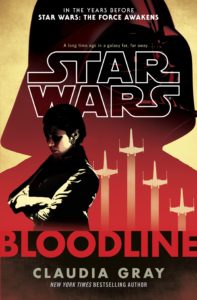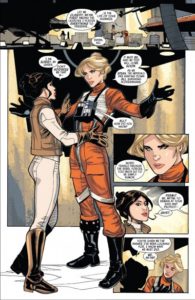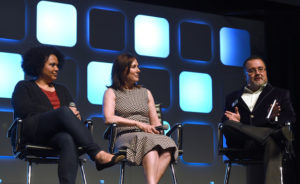It’s no secret to anyone who knows me well that I’m not altogether fond of the way that the new post-ROTJ canon has treated Leia. By the time we see her in The Force Awakens, her career is shattered, her marriage is strained, and her only son has become a Vader-worshipping genocidal maniac. These are not the kinds of things that I ever would have said that I wanted for my favorite character. Half the time I go around sad for her fate and the rest of the time I go around scared for what the future of Star Wars storytelling has in store for her. But this is not an article about that. This is…well… the opposite.
One of my chief complaints about the (much beloved) Legends universe of storytelling was that Leia’s character seemed to be difficult for many writers to nail down, and even more difficult to keep consistent across multiple series and authors. As much as abuse as the new canon has heaped onto Leia, that particular violation is gladly absent from her current portrayal. One of the best things I have found about the new canon and the work of the Lucasfilm Story Group is the fantastic job they’ve done with the internal consistency of the universe- not only as it pertains to the events in the Galaxy as a whole, but also in the portrayals of the passions and the motivations of the individual characters.
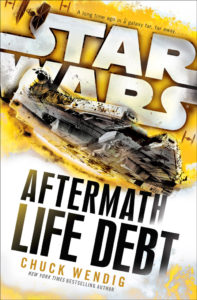 Having recently read (and re-read) Life Debt, the second book in Chuck Wendig’s Aftermath series, I couldn’t help but be struck by Leia’s portrayal. Leia is my favorite character, she’s the reason I ever cared about Star Wars to begin with, so it’s only natural that I paid special attention to her in Life Debt. Her arc over the course of the book is both believable and well expressed, but that alone is not enough to warrant my unmitigated joy. The thing that has me cheering (and writing very involved articles) is how her actions in this book give me answers to questions I had after having read Claudia Gray’s Bloodline (four times) earlier this year. Gray’s exquisite novel chronicling Leia’s life and career nearly a quarter century after the battle of Endor left me with lots of questions as to the intervening years. There is very little in the world that I love more than a book that makes me think that much. Bloodline is the kind of novel that I could have enjoyed casually just for its surface awesomeness, but the fact that it was so thought provoking just made it that much more of a win in my esteem.
Having recently read (and re-read) Life Debt, the second book in Chuck Wendig’s Aftermath series, I couldn’t help but be struck by Leia’s portrayal. Leia is my favorite character, she’s the reason I ever cared about Star Wars to begin with, so it’s only natural that I paid special attention to her in Life Debt. Her arc over the course of the book is both believable and well expressed, but that alone is not enough to warrant my unmitigated joy. The thing that has me cheering (and writing very involved articles) is how her actions in this book give me answers to questions I had after having read Claudia Gray’s Bloodline (four times) earlier this year. Gray’s exquisite novel chronicling Leia’s life and career nearly a quarter century after the battle of Endor left me with lots of questions as to the intervening years. There is very little in the world that I love more than a book that makes me think that much. Bloodline is the kind of novel that I could have enjoyed casually just for its surface awesomeness, but the fact that it was so thought provoking just made it that much more of a win in my esteem.
When Ransolm Casterfo says to Leia in Chapter 8 of Bloodline that it’s a pity she never stood for Chancellor because she’s “a powerful leader, someone with lasting moral authority,” I was left asking why: why a person with such strong convictions, a person who has a clear path to leadership, a person who has spent a lifetime in the service of the people of the Galaxy would never have risen to any sort of position of power within the New Republic bureaucracy. Even Han says to her in Bloodline that he doesn’t see what she gets out of politics. Going into Life Debt, I have to admit that I was asking basically the same brand of question.
How is it that Leia, who the Legends universe had running the galaxy within a decade of the victory at Endor, is spending the new canon sitting idly in the Senate for a quarter century? How does that even make sense?
I found my answers in Life Debt.
We learn in the first Aftermath book that Leia has become the visible symbol of the New Republic. Not only is she the heir apparent to Chancellor Mon Mothma, but it’s a hologram of her speaking that’s making the rounds of the outer rim planets- telling hopeful citizens that the New Republic is coming for them. Leia is the face of galactic liberation. Leia is the voice that’s reaching out to far-flung systems telling them that freedom from Galactic Tyranny is at hand. And in Life Debt when Mas Amedda comes to Velusia to surrender what’s left of the Empire, and to symbolically put an end to that tyranny, he brings himself before the combined forces of Mon Mothma and Princess Leia.
At this point in the story, Leia is clearly in league with Mon Mothma. She’s playing a key executive role in the fledgling New Republic government. She is being treated with the same deference and reverence as the Chancellor herself; even being encouraged to take on a protective detail (which, in true Leia form, she sharply declines). The New Republic Senate is seated, and it’s made clear that Leia is welcome to address the body- as she mentions to Han Solo in the opening scene of the book. And yet we can discern from that same conversation as well as a comment made in later in the book, that Leia is not sitting in the Senate full-time. It becomes apparent early in the book that Leia’s position during this transitional period, although largely symbolic, is very much in the upper echelon of leadership. So is it any wonder that I had questions as to the direction her career took in the years between this moment and the events of Bloodline?
By the end of the book, I was no longer wondering. In fact, by the end of the book I had answers to questions that I’d had since TFA (the second time; after the first time all I could do was cry over Han Solo).
By Chapter 29 of Life Debt (a little more than two thirds of the way through the book), Leia says that she feels like one of Mon Mothma’s “discarded instruments”. When Leia makes it clear that she will do what is right over what is politic, Mon Mothma (who, strangely enough, just prior to Amedda’s failed surrender asks Leia what has happened to her idealism) seems to be absolutely shocked that Leia would “injure the New Republic” over her strong convictions pertaining to the liberation of Kaskyyyk. Leia’s answer to that: “I would burn down the whole galaxy if I thought it was right.”
During this period in galactic history, Leia is barely into her twenties. She has spent the entirety of her brief adulthood engaged in open, front-line warfare against the Empire and that has forged her into a person who can’t sit idly by and wait for bureaucracy to address injustice. Even Ransolm Casterfo, as her political adversary in Bloodline, sees that in her; declaring her to be someone who knows, “when to stop debating and take action.” That’s the Leia we see here in Life Debt. We see that when Leia said in Aftermath that “the New Republic is coming to help” systems suffering under the Empire, she meant it. And in the events of Life Debt, we see that she means to make good on that herself if she has to- starting with the citizens of Kashyyyk.
“We have fought to be good,” she reminds Mon Mothma, “to be heroes! But now?” she challenges, “You want to negotiate this middle space. You want to dither about in the gray.” Dithering about is something that the Leia of Life Debt and the Resistance General in TFA both have no patience for. 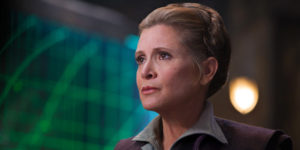
Mon Mothma tries to explain that the reality of the transition to peacetime means that they cannot continue to behave with the impetuousness and autonomy of the insurgency that up until recently was their SOP. She says that as a proper, functioning administration that they “are beholden to the whole, to the machine of government.” Leia is not ready for the reality of being beholden to the machine of government. Spending her young adulthood fighting a war has left her with no patience for that machine. She also has no patience for the idea of negotiating those things that she finds non-negotiable. But as much as Leia insists that issues are as cut and dry as good and evil, Mon Mothma and the New Republic establishment see it differently. To Mon Mothma, it’s politics as usual. She will handle things the correct way, even if it allows suffering to persist in the mean time.
“Meet the new tax collector, same as the old tax collector,” Han Solo says to a fellow scoundrel in the Legends book Honor Among Thieves. And in response to Leia’s holographic message of forthcoming liberation in Aftermath, Sinjir declares, “One conqueror replaces another.” The rest of this exchange between Leia and Mon Mothma shows us that Leia is starting to view the New Republic in this same light.
It seems to me from what we see in the latter half of Life Debt that Leia is not as committed to the New Republic government as she thought she would be. She remains committed to what she fought for, but less so to what it’s becoming. We come to understand fully over the course of the book that Leia is, at her core, much more concerned about what is right than what is “correct” and that she is angered that the government that she fought so hard and gave up her youth for is not the government that she is getting as the war draws to an end. The new tax man looks an awful lot like the old tax man.
Mon Mothma finds this proverbial gray area even on things that, in Leia’s eyes, are morally absolute. And any ability to turn a blind eye to the plight of a suffering people while allowing bureaucracy to take its time in making things better feels to Leia like the way the Empire would behave. And for Leia, who equates the Empire to absolute evil, seeing any shades of that in the new regime is unacceptable. Although her path at the beginning of Life Debt seems to be set in the same direction that she took in the Legends universe, by the end of the book, the office of Chancellor (and in fact the whole business of the way the government is operating) has left a bad taste in Leia’s mouth. When we hear her say, “I’d rather be alone than with you, Chancellor,” we get to see a princess and politician taking her first steps away from the line she was raised to tow and onto the path that leads straight to a leased hangar full of detonators on Hosnian Prime.
By the end of Life Debt, we are seeing a Leia who is ready to walk away from Mon Mothma and the New Republic government altogether. So then I asked myself why a person whose been through those things- who has had their dearly held convictions and their life’s mission challenged by the realities of bureaucracy- would spend the next quarter century participating in that reality. I found those answers in Life Debt as well.
In an interlude meeting the officers serving in the Alderaan Flotilla, we see that much of the Alderaani diaspora still hold a great deal of admiration for and devotion to their surviving Princess. But they are concerned for their future and displeased at having no current representation in the Galactic Senate. Knowing as we do the fact that she was their elected representative for years before the destruction of their planet, it’s easy to predict their asking her to serve them in a similar capacity under the New Republic. And knowing as we do (from the events of the Princess Leia comic series) the power of Leia’s devotion to her people, it’s only natural to presume that she would perform that duty when called upon. It’s the Leia of the comics who agrees to sit in the Senate and who spends a large portion of her life dealing with the gridlock and the political quagmire, but it is the Leia of Life Debt who gives it all up and walks away to form the Resistance.
These two versions of Leia: the woman who is solely committed to the ideals for which she fought and the woman who spends a career working within the less-than-ideal government that resulted from that fight are two sides of the same coin. She is the Princess and the General. She is the warrior and the politician. We can see clear the path that Leia sets herself on in Life Debt coming to fruition in Bloodline; up to and including the moment when she finally gives up entirely on being part of government and strikes out on her own. Looking closely, we can see the birth of the Resistance from the end of Life Debt. When Leia climbs aboard the Moth and admits that she is joining the mission without the blessing of the New Republic administration, we get an early glimpse of General Organa. What a great gift to Leia fans. It’s a welcome change from the Legends universe where she was often times unrecognizable from the films and almost universally inconsistent from one book to the next. Having this consistent portrayal of the character- one wherein we can draw a straight line from where she is to where she is going- is a gift that I don’t take lightly.
When the canon was rebooted, we fans were assured over and over again that there would be quality and consistency in the new expanded universe. At this point in the journey, I could not be happier with the result.

